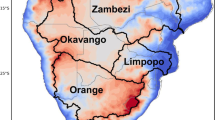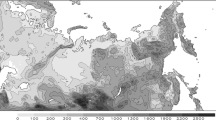Abstract
Under a warming climate, changes in hydrological extremes may be more significant than changes in hydrological mean conditions. Due to the high risk of damage and the increasing trends of floods and droughts in Germany, the potential changes in hydrological extreme events are of high importance. However, projections of extreme events particularly for floods are associated with large uncertainties and depend on climate scenarios. If only a few scenarios are applied, there is a danger that the impact assessment is biased. This study aims to evaluate the performance of a set of climate scenarios from the ENSEMBLES project for flood and drought projections and to detect the robust changes using the eco-hydrological model SWIM in five large river basins covering 90 % of the German territory. The study shows that there is a moderate certainty that most German rivers will experience more extreme 50-year floods and more frequent occurrences of 50-year droughts. Projected changes with a high certainty include an increasing trend of floods in the Elbe basin and more frequent extreme droughts in the Rhine basin in 2061–2100. Wetter conditions, i.e., more extreme floods and less frequent droughts, are projected for the alpine rivers in 2021–2060. Using only those RCMs for impact assessments that perform best in the reference period does not guarantee more consistent and certain future projections. Hence, the use of the whole ensemble of available scenarios is necessary to quantify the “full” range of uncertainties corresponding to the current state of knowledge and assuring the robustness of projected change patterns.







Similar content being viewed by others
References
Arnold JG, Williams JR, Nicks AD, Sammons NB (1990) SWRRB: a basin scale simulation model for soil and water resources management. Texas A & M University Press, College Station
Arnold JG, Srinivasan R, Muttiah RS, Williams JR (1998) Large area hydrologic modeling and assessment, part I: model development. J Am Water Resour Assoc 34(1):73–89
Bronstert A, Engel H (2011) Veränderungen der Abflüsse. In: Lozan JL, Graßl H, Hupfer P, Krabe L, Schönwiese CD (eds) Warnsignal Klima. Genug Wasser für alle? Wissenschaftliche Auswertungen, 3. Hamburg, Auflage pp 291–301
Cameron D (2006) An application of the UKCIP02 climate change scenarios to flood estimation by continuous simulation for a gauged catchment in the northeast of Scotland, UK (with uncertainty). J Hydrol 328(1):212–226
Christensen OB, Christensen JH (2004) Intensification of extreme European summer precipitation in a warmer climate. Glob Planet Change 44:107–117. doi:10.1016/j.gloplacha.2004.06.013
Coles S (2001) An introduction to statistical modeling of extreme values. Springer, London
Dankers R, Feyen L (2009) Flood hazard in Europe in an ensemble of regional climate scenarios. J Geophys Res 114:D16108. doi:10.1029/2008JD011523
Dankers R, Christensen OB, Feyen L, Kalas M, de Roo A (2007) Evaluation of very high-resolution climate model data for simulating flood hazards in the upper Danube basin. J Hydrol 347:319–331
Dynesius M, Nilsson C (1994) Fragmentation and flow regulation of river systems in the northern third of the world. Science 266:753–762
Ehret U, Zehe E, Wulfmeyer V, Warrach-Sagi K, Liebert J (2012) HESS opinions “should we apply bias correction to global and regional climate model data?”. Hydrol Earth Syst Sci Discuss 9:5355–5387
ENSEMBLES (2009) Climate change and its impacts at seasonal, decadal and centennial timescales. Final report, p 164 http://www.ensembles-eu.org
Faramarzi M, Abbaspour KC, Vaghefi SA, Farzaneh M, Zehnder AJB, Srinivasan R, Yang H (2013) Modeling impacts of climate change on freshwater availability in Africa. J Hydrol 480:85–101
Feyen L, Dankers R (2009) Impact of global warming on streamflow drought in Europe. J Geophys Res 114:D17116. doi:10.1029/2008JD011438
Fleig AK, Tallaksen LM, Hisdal H, Demuth S (2006) A global evaluation of streamflow drought characteristics. Hydrol Earth Syst Sci 10:535–552
Gelfan A, Pomeroy J, Kuchment L (2004) Modelling forest cover influences on snow accumulation, sublimation, and melt. J Hydrometeorol 5(5):785–803
Giorgi F, Coppola E (2010) Does the model regional bias affect the projected regional climate change? An analysis of global model projections. Clim Change 100:787–795
Graham LP, Andréasson J, Carlsson B (2007) Assessing climate change impacts on hydrology from an ensemble of regional climate models, model scales and linking methods—a case study on the Lule river basin. Clim Change 81(Suppl. 1):293–307. doi:10.1007/s10584-006-9215-2
HAD (Hydrologischer Atlas von Deutschland) (2000) Bundesministerium für Umwelt, Naturschutz und Reaktorsicherheit, ISBN:3-00-005624-6
Hawkins E, Sutton R. (2012) Time of emergence of climate signals. Geophys Res Lett 39:L01702. doi:10.1029/2011GL050087
Hennegriff W, Ihringer J, Kolokotronis V (2008) Prognose von Auswirkungen des Klimawandels auf die Niedrigwasser-verhältnisse in Baden-Württemberg. Korresp Wasserwirtsch 6(1):309–314. doi:10.3243/kwe2008.06.003 (in German)
Hooghoudt SB (1940) Bijdrage tot de kennis van enige natuurkundige grootheden van de grond. Versl Landbouwkd Onderz 46(14):515–707
Huang S, Krysanova V, Österle H, Hattermann FF (2010) Simulation of spatiotemporal dynamics of water fluxes in Germany under climate change. Hydrol Process 24(23):3289–3306
Huang S, Hattermann FF, Krysanova V, Bronstert A (2012a) Projections of impact of climate change on river flood conditions in Germany by combining three different RCMs with a regional hydrological model. Clim Change. doi:10.1007/s10584-012-0586-2
Huang S, Krysanova V, Hatterman FF (2012b) Projection of low flow conditions in Germany under climate change by combining three RCMs and a regional hydrological mode. Acta Geophys. doi:10.2478/s11600-012-0065-1
Hurkmans R, Terink W, Uijlenhoet R, Torfs PJJF, Jacob D, Troch PA (2010) Changes in streamflow dynamics in the Rhine basin under three high-resolution climate scenarios. J Clim 23(3):679–699. doi:10.1175/2009JCLI3066.1
IPCC (1996) Climate change 1995: the science of climate change. In: Houghton JT, Meira Filho LG, Callander BA, Harris N, Kattenberg A, Maskell K (eds) Cambridge University Press, Cambridge, United Kingdom and New York, NY, USA, p 572
IPCC (2012) Managing the risks of extreme events and disasters to advance climate change adaptation. In: Field CB, Barros V, Stocker TF, Qin D, Dokken DJ, Ebi KL, Mastrandrea MD, Mach KJ, Plattner GK, Allen SK, Tignor M, Midgley PM (eds) A special report of working groups I and II of the intergovernmental panel on climate change. Cambridge University Press, Cambridge, UK, and New York, NY, USA, p 582
Jacob D (2001) A note on the simulation of the annual and inter-annual variability of the water budget over the Baltic Sea drainage basin. Meteorol Atmos Phys 77:61–73
Katz RW, Brown BG (1992) Extreme events in a changing climate: variability is more important than averages. Clim Change 21:289–302
Kay A, Jones R, Reynard N (2006) RCM rainfall for UK flood frequency estimation. II. Climate change results. J Hydrol 318(1):163–172
Kay A, Davies H, Bell V, Jones R (2009) Comparison of uncertainty sources for climate change impacts: flood frequency in England. Clim Change 92(1):41–63
Kling H, Fuchs M, Paulin M (2012) Runoff conditions in the upper Danube basin under an ensemble of climate change scenarios. J Hydrol 424–425:264–277
Kosková R, Nemecková S, Hesse C, Jakubíková A, Broza V, Szolgay J (2007) Using of the soil parameterisation based on soil samples databases in rainfall-runoff modelling. In: Jakubíková A, Broza V, Szolgay J (eds) Proceedings of the Adolf Patera workshop “Extreme hydrological events in catchments”, Bratislava, 2007
Krysanova V, Meiner A, Roosaare J, Vasilyev A (1989) Simulation modelling of the coastal waters pollution from agricultural watersheds. Ecol Model 49:7–29
Krysanova V, Möller-Wohlfeil D, Becker A (1998) Development and test of a spatially distributed hydrological/water quality model for mesoscale watersheds. Ecol Model 106:261–289
Krysanova V, Wechsung F, Arnold J, Srinivasan R, Williams J (2000) PIK Report Nr. 69 “SWIM (soil and water integrated model), User Manual”, p 239
Lehner B, Doll P, Alcamo J, Henrichs T, Kaspar F (2006) Estimating the impact of global change on flood and drought risks in Europe: a continental, integrated analysis. Clim Change 75(3):273–299
Lenderink G, Buishand A, van Deursen W (2007) Estimates of future discharges of the river Rhine using two scenario methodologies: direct versus delta approach. Hydrol Earth Syst Sci 11(3):1145–1159
Mauser W, Marke T, Stoeber S (2008) Climate change and water resources: scenarios of low-flow conditions in the upper Danube river basin. IOP Conf Ser Earth Environ Sci 4(1):012027. doi:10.1088/1755-1307/4/1/012027
Munich Re (2009) SystemAgro: sustainable crop insurance in response to climate change. http://www.munichre.com/app_pages/www/@res/pdf/reinsurance/business/non-life/systemagro/sustainable_crop_insurance_en.pdf
Nash JE, Sutcliffe JV (1970) River flow forecasting through conceptual models. Part I: a discussion of principles. J Hydrol 10(3):282–290
Petrow T, Merz B (2009) Trends in flood magnitude, frequency and seasonality in Germany in the period 1951–2002. J Hydrol 371:129–141
Priestley CHB, Taylor RJ (1972) On the assessment of surface heat flux and evaporation using large scale parameters. Mon Weather Rev 100:81–92
Raisanen J, Ruolokainen L, Ylhaisi J (2010) Weighting model results for improving best estimates of climate change. Clim Dyn. doi:10.1007/s00382-009-0659-8
Rockel B, Will A, Hense A (2008) The regional climate model COSMO-CLM (CCLM). Meteorol Z 17(4):347–348
Rojas R, Feyen L, Dosio A, Bavera D (2011) Improving pan-European hydrological simulation of extreme events through statistical bias correction of RCM-driven climate simulations. Hydrol Earth Syst Sci 15:2599–2620
Sangrey DA, Harrop-Williams KO, Kaliber JA (1984) Predicting ground-water response to precipitation. ASCE J Geotech Eng 110(7):957–975
Smedema LK, Rycroft DW (1983) Land drainage: planning and design of agricultural drainage systems. Cornell University Press, Ithaca p 376
Stahl K, Hisdal H, Hannaford J, Tallaksen LM, van Lanen HAJ, Sauquet E, Demuth S, Fendekova M, Jódar J (2010) Streamflow trends in Europe: evidence from a dataset of near-natural catchments. Hydrol Earth Syst Sci 14:2367–2382
Svensson C, Kundzewicz WZ, Maurer T (2005) Trend detection in river flow series: 2. Flood and low-flow index series. Hydrol Sci J 50(5):824–881
Tebaldi C, Knutti R (2007) The use of the multi-model ensemble in probabilistic climate projections. Philos Trans R Soc Lond A 365:2053–2075
Teutschbein C, Seibert J (2010) Regional climate models for hydrological impact studies at the catchment scale: a review of recent modeling strategies. Geogr Compass 4(7):834–860
Thieken AH, Müller M, Kreibich H, Merz B (2005) Flood damage and influencing factors: new insights from the August 2002 flood in Germany. Water Resour Res 41:W12430. doi:10.1029/2005WR004177
Williams J, Renard K, Dyke P (1984) EPIC: a new model for assessing erosion’s effect on soil productivity. J Soil Water Conserv 38(5):381–383
Zelenhasic E, Salvai A (1987) A method of streamflow drought analysis. Water Resour Res 23(1):156–168
Author information
Authors and Affiliations
Corresponding author
Electronic supplementary material
Below is the link to the electronic supplementary material.
Rights and permissions
About this article
Cite this article
Huang, S., Krysanova, V. & Hattermann, F. Projections of climate change impacts on floods and droughts in Germany using an ensemble of climate change scenarios. Reg Environ Change 15, 461–473 (2015). https://doi.org/10.1007/s10113-014-0606-z
Received:
Accepted:
Published:
Issue Date:
DOI: https://doi.org/10.1007/s10113-014-0606-z




